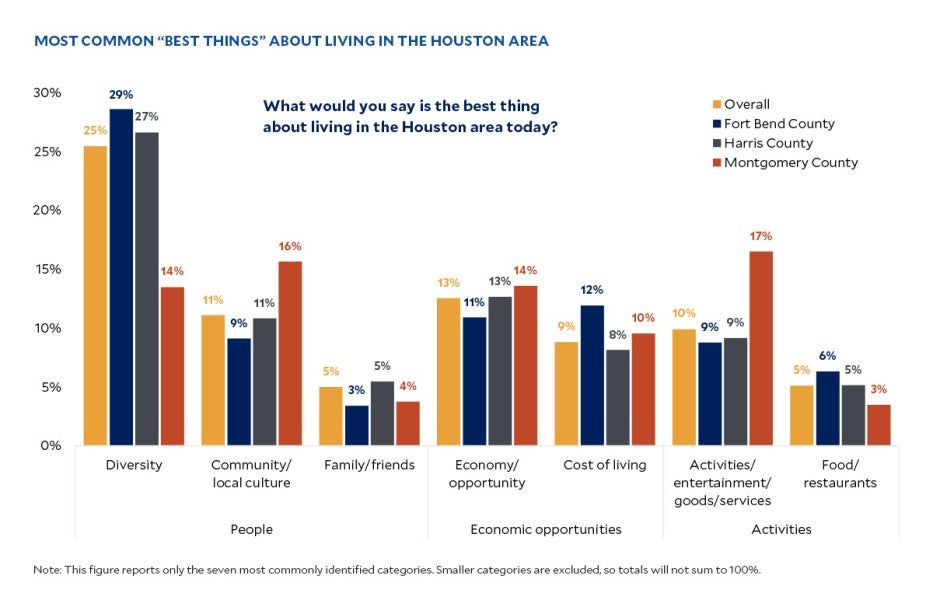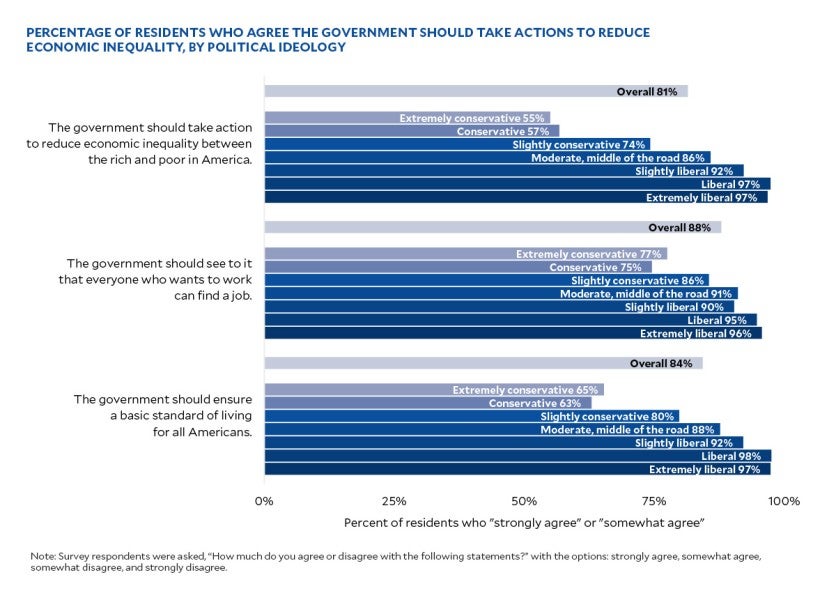People across all three counties share a civic identity as “Houstonians” and take pride in the area’s diversity and opportunities. They also recognize how the issues of immigration, inequality and infrastructure must be grappled with to ensure shared prosperity and future growth.
This post is part of a series highlighting the findings from the 2025 Kinder Houston Area Survey.
For the first time, the Greater Houston Community Panel is not exclusive to Harris County. New members from neighboring Fort Bend and Montgomery counties provided insights this year and will be included in the panel’s ongoing surveys. (Residents in Fort Bend and Montgomery counties have not been included in the annual Kinder Houston Area Survey since 2018.)
The 2025 survey was fielded online in January and February in English and Spanish. Across the three-county region, about 9,800 adults — of all ages, reflective of the ethnic and racial makeup of the area, with varying levels of annual income and educational attainment — responded.
While some beliefs and concerns differed across locations or political ideologies, the Urban Edge identified five areas where Houston is clearly in agreement.
1. We are “Houstonians.”
Throughout the three-county region, most residents were either born in the Houston area or moved here as an adult. About half of residents of Fort Bend and Montgomery counties moved to the area as adults and a third were born here. In Harris County, 41% of residents were born in the area, and 39% of residents moved in as adults. In each county, 20% or less of residents moved to the Houston area as a child.
Regardless of county or when they arrived, 80% of survey participants consider themselves to be a Houstonian. In addition to the collective sense of identity, the same percentage of residents believe that the Houston area is a better place to live than other major metro areas. And across all three counties, between 60% and 75% of residents have lived here more than 15 years.
2. Houston’s superpowers are its culture, diversity and opportunity.
When asked what the “best things” about living in Houston are, three categories accounted for over 70% of responses: people, economic opportunities and activities.
About 1 in 4 residents cited diversity as the best thing, and nearly 9 in 10 believe its culture is “good,” “very good” or “excellent.”
Another 1 out of 4 said economic opportunities were the best thing, because of the availability of jobs, careers and the cost of living. Responses that received smaller amounts of support included community and local culture, family and friends, activities, entertainment, goods and services, and the food and restaurant scene.
Seventy-six percent of respondents said the region’s higher education institutions are good, very good or excellent, and 70% said the same of the region’s job opportunities.
3. Government needs to ensure access to jobs and reduce wealth inequality.
To promote shared prosperity in the region, a majority of survey respondents — across the political spectrum — said government entities should help job seekers with access to employment opportunities and have a responsibility to close income gaps.
The statement “the government should see to it that everyone who wants to work can find a job” received 88% support overall, while 81% agreed that “the government should take action to reduce economic inequality between the rich and poor. The level of agreement with these statements marked all-time highs in the survey’s history.
In the survey’s three-county region, 14% of respondents said they make less than $25,000 annually, and 17% have an annual income of $25,000-$49,999. If faced with an unexpected expense, 45% of Harris County residents, 37% of Montgomery County residents and 34% of Fort Bend County residents would not be able to afford it.
4. Immigrants are assets, regardless of documented status.
Survey respondents were mostly supportive of the contributions immigrants make to the U.S. economy, regardless of their legal status.
Majorities in all three counties believe immigrants contribute more than they take from the economy, with Harris and Fort Bend residents agreeing at higher rates (72% and 71%, respectively) than those of Montgomery (61%). Majorities in Harris (64%) and Fort Bend (56%) also agreed that undocumented immigrants contribute more than they take. Nearly half (48%) of Montgomery County residents said the same.
Houstonians also believe there is a place in the region for immigrants without legal status to live and work.
Seventy-two percent of respondents disagreed with the idea that “the Houston area would be better off if all undocumented immigrants were deported,” and 68% disagreed that “undocumented migrants are a major cause of unemployment.”
5. Houston is great, but needs to address infrastructure and environmental quality.
Residents praised many aspects of life in Houston, and 83% of Fort Bend County residents, 71% of Harris County residents and 80% of Montgomery County residents rated their quality of life as good, very good or excellent.
However, they also identified areas for improvement. Though not regarded as the most pressing issues facing the region, respondents gave low ratings on local infrastructure, public transit, and air and water quality.
More than 6 in 10 rated local infrastructure as either poor or fair, with 23% of Fort Bend County residents, 30% of Harris County residents and 28% of Montgomery County residents rating it as poor.
Fort Bend County and Montgomery County residents had the least favorable ratings of public transportation, with about 70% in each saying it was poor or fair compared to 63% in Harris County.
Almost 1 in 4 Harris County residents rated their air and water quality as poor, and 4 in 10 rated it as fair. Harris County has the highest number of pollution sources linked to health risks in Texas, according to a 2024 analysis by Harris County Public Health.




